Scosche BT100 BLUETOOTH HEADSET User Manual BTE01 QSG
Scosche Industries Inc BLUETOOTH HEADSET BTE01 QSG
Scosche >
User Manual

Button Functions
Phone button
- When playing music, press and release to pause
music; press and release again to play music.
- When receiving an incoming call, press and
release to answer; press and release to end the
call.
- Press twice quickly to call the last
number dailed.
Note: When playing music and a call comes in, the
music will pause and you will hear a ringtone.
The music will resume when the call is ended.
Volume up/track forward
- Press to play next track
- Press and hold to raise volume
Volume down/track back
- Press to play previous track
- Press and hold to lower volume
Note: The button functions may vary per device.
Charging
Note: Make sure your BT100 is fully charged
before using it for the first time.
- Gently plug the Micro-USB end of the included
charging cable into the charge port of the
control box.
- Plug the USB end of the cable into a powered
USB port, such as a computer, laptop, or a USB
AC adapter (not included).
- The LED indicator located on the control box will
glow red. Once the headset is fully charged, the
LED power indicator will turn off.
Note
- The LED indicator will light up red while charging
even if the BTE01 is off.
- You cannot charge your BT100 while listening to
music.
Connect via Bluetooth®
(first time set-up)
Note: Adjust the volume of your device and
the BT100 to a comfortable volume
before use.
- Move the power swithc on the side of the BT100
to the “ON” position. The LED indicator light on
the control box will flash blue.
- Open the settings on your Bluetooth device
(Bluetooth must be enabled).
- Select “SCOSCHE BT100” from the list of Bluetooth
devices.
- Once paired, the LED indicator light will flash
blue slowly.
- To turn off the BT100, move the power switch on
the side to the “OFF” position.
Controls
LED indicator
Microphone
Volume up/
track forward
Volume down/
track back
Phone
button
Micro
USB port
This device complies with part 15 of the FCC Rules. Operation is subject to the condition that this device does not cause harmful
interference (1) this device may not cause harmful interference, and (2) this device must accept any interference received,
including interference that may cause undesired operation.
Changes or modifications not expressly approved by the party responsible for compliance
could void the user's authority to operate the equipment.
NOTE: This equipment has been tested and found to comply with the limits for a Class B digital device, pursuant to Part 15 of the
FCC Rules. These limits are designed to provide reasonable protection against harmful interference in a residential installation.
This equipment generates, uses and can radiate radio frequency energy and, if not installed and used in accordance with the
instructions, may cause harmful interference to radio communications. However, there is no guarantee that interference will not
occur in a particular installation.
If this equipment does cause harmful interference to radio or television reception,
which can be determined by turning the equipment off and on, the user is encouraged to try to correct the interference by one or
more of the following measures:
-- Reorient or relocate the receiving antenna.
-- Increase the separation between the equipment and receiver.
-- Connect the equipment into an outlet on a circuit different
from that to which the receiver is connected.
-- Consult the dealer or an experienced radio/TV technician for help.
The device has been evaluated to meet general RF exposure requirement. The device can be used in portable exposure condition
without restriction.
FCC ID: BT100